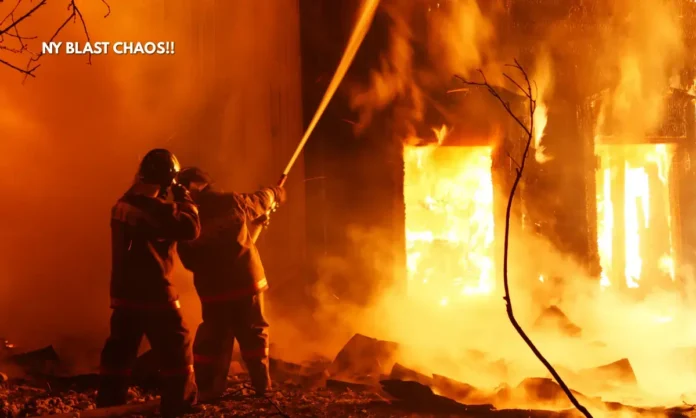Summary
- A massive explosion rocks New York’s Upper East Side at approximately 10 a.m. on August 15, triggering a three-alarm fire atop a seven-story building.
- Firefighters arrived within four minutes; 170 FDNY and EMS personnel responded, containing the blaze to the epicenter and preventing spread.
- Three firefighters and one building superintendent sustained minor injuries, and the incident is under active investigation with gas shut off and air quality advisories issued.
Gripping Recount from East 95th Street
At just after 10 a.m. on August 15, 2025, a massive explosion rocks New York as residents on the Upper East Side reported the entire building shaking—some thought a truck had hit it or even felt an earthquake-like tremor. Within minutes, thick black smoke began pouring into the skyline, signaling the severity of the rooftop blaze. The massive explosion rocks New York poignantly frames the urgency of that moment. First responders, already on high alert, streamed toward 305 East 95th Street—undoubtedly aware that in New York a single explosion can echo across neighborhoods.
Aaaaand here’s the distraction…
— {Matt} $XRPatriot (@matttttt187) August 15, 2025
❌ Explosion in New York City's Upper East Side; 100 firefighters and first responders at the scene. Cause unknown. pic.twitter.com/rUOCXz7iLC
Rapid Emergency Response
A call came in near 10:04 a.m., prompting FDNY units to arrive within four minutes. Fire quickly spread from the roof to the cockloft and three penthouses before being contained.
A massive explosion rocks New York, and the coordinated response involved about 170 firefighters, EMS personnel, and emergency units—highlighting the scale of the operation.
Notify NYC issued alerts advising residents to close windows to shield against the thick smoke and avoid the area due to smoke and traffic impacts.
Each mention of how the massive explosion rocks New York underscores how sudden and dramatic the incident felt to onlookers and responders alike.
Personal Accounts and Human Impact
Residents recalled hearing an abrupt boom—“the entire building shook,” one said; another described waking to a terrifying roar and immediate panic.
No fatalities were reported, but three firefighters and the building superintendent, who was in the basement, suffered minor injuries while combating the blaze.
Witness reflections underscore the title’s resonance—how a massive explosion rocks New York, even when the physical origin is a fire, not a seismic event.
Structural and Safety Context
The fire began on the roof of a seven-story apartment building between First and Second Avenues and spread downward into vulnerable structural areas like the cockloft and penthouses.
Inspectors have since conducted structural stability checks, and gas has been shut off in the affected building. The cause remains under investigation.
In reflecting on how a massive explosion rocks New York, it becomes clear how fragile older buildings can be under sudden emergencies—and how critical early containment is.
Broader Emergency Coordination
FDNY’s swift call and response highlight preparedness and training. The magnitude of the incident—described both in visuals and prompts like “massive explosion rocks New York”—elicited a city-wide sense of alarm.
The Office of Emergency Management (OEM) and Notify NYC coordinated public messaging, mitigating panic by urging residents to remain vigilant but calm.
This coordination underscores how the phrase massive explosion rocks New York encapsulates not just shock, but also the rapid outpouring of institutional response.
Lessons and Critical Reflection
The phrase massive explosion rocks New York reframes the incident—though a fire caused it, the impact resembled a shockwave event. This wording may prompt evaluation of building codes, fire safety protocols, and communications clarity.
It reminds us how easily everyday life in New York can be disrupted—how a rooftop fire can shower smoke across Central Park, rattle hearts, and demand mobilization of hundreds of emergency personnel.
Comparing to historical events—such as the 2015 East Village gas explosion that had devastating casualties and property loss—this incident, while contained, offers a beacon for reviewing emergency readiness and preventive infrastructure maintenance.
Forward-Looking Considerations
What might follow this dramatic incident where a massive explosion rocks New York?
Investigators will aim to clarify the ignition source—whether accidental gas buildup, construction mishap, or otherwise—and advise preventive changes.
Building management will likely face scrutiny regarding rooftop safety, structural conditions of penthouses and cocklofts, and compliance with city permits or stop-work orders.
Public communication platforms like Notify NYC may adapt alert wording—using clearer terms to differentiate between explosion versus fire from the outset.
The phrase massive explosion rocks New York could become shorthand within city agencies for events that combine shock value and high-risk fire scenarios—even framing future training protocols.
Coda: The Lasting Echo of Alarm
By late afternoon on August 15, the flames had been extinguished, the smoke cleared, and emergency responders stood down. Residents shuddered at what they’d heard and seen—the jolt, the black sky, the sirens converging—moments when a massive explosion rocks New York, and time slows.
While the frontline damage was confined, the ripple effects of that phrase—echoing on social feeds, local radios, and emergency dispatch logs—will outlast the smoke.


